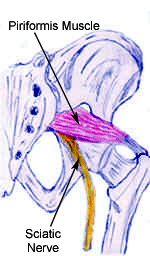|
Conditions & Treatments - Piriformis Syndrome |

Are you experiencing pain in your buttock/hip/back which runs down the back of your leg? Has performing everyday activities become more challenging and difficult because of these symptoms. If this is your situation, then you may be experiencing a condition called piriformis syndrome. This condition is often associated with sciatica and can be diagnosed and easily treated by a physical therapist. |
|
What is Piriformis Syndrome?  Piriformis
syndrome is a condition in which the piriformis, a muscle that lies
deep beneath your gluteal muscle in the buttock, irritates the sciatic
nerve, causing pain in the buttock, hip and low back areas. The image
provided displays the piriformis muscle as it attaches to the sacrum
(tailbone) and runs diagonally to the outside of the femur bone. The sciatic
nerve usually runs beneath the piriformis, but in some individuals, the
nerve runs directly through the muscle. If the muscle is excessively tight,
it can compress and irritate the sciatic nerve. Often times this will result
in referred pain down the back of the thigh, called sciatica. Common
complaints with piriformis syndrome are deep pain in the buttock/hip area,
which increases with sitting, bending/squatting, or climbing stairs. This
condition can also be common in athletes who run a great deal as the
piriformis muscle may try to compensate for weakness in the lower leg or
ankle regions. Piriformis
syndrome is a condition in which the piriformis, a muscle that lies
deep beneath your gluteal muscle in the buttock, irritates the sciatic
nerve, causing pain in the buttock, hip and low back areas. The image
provided displays the piriformis muscle as it attaches to the sacrum
(tailbone) and runs diagonally to the outside of the femur bone. The sciatic
nerve usually runs beneath the piriformis, but in some individuals, the
nerve runs directly through the muscle. If the muscle is excessively tight,
it can compress and irritate the sciatic nerve. Often times this will result
in referred pain down the back of the thigh, called sciatica. Common
complaints with piriformis syndrome are deep pain in the buttock/hip area,
which increases with sitting, bending/squatting, or climbing stairs. This
condition can also be common in athletes who run a great deal as the
piriformis muscle may try to compensate for weakness in the lower leg or
ankle regions.
Diagnosis of piriformis syndrome is made primarily on the basis of symptoms and physical examination. A Physical Therapist will perform a series of tests to rule out other causes of the pain, and to locate the origin of pain. Other possible causes of sciatica may be hamstring tendonitis, lumbar disc herniation or other lumbar spine diseases. Therefore, a thorough examination of the lower back and lower extremities are necessary to correctly develop a treatment plan. |
Piriformis Syndrome Treatment Options for a PT
· Hot Packs/Ice Packs
· Postural Training/Functional Training
· ROM/Stretching (see videos 26, 27, & Z4)
· Strengthening (see videos Z12 & Z13)
· Massage/Soft Tissue Mobilization
· Gait Training
· Ultrasound
| Comment - Message Board |
Last revised: January 1, 2008
by Chai Rasavong, MPT
|
|
|
|





